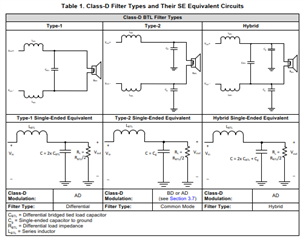From past work, I'm familiar with the various output filter types that are typically found after the power stages of most class-D amplifiers.
TI's SLAA701A app note, as well as the LC designer tool, reference three filter types as shown below:

Given that I'm working with an AD-modulated amp IC (the TPA3245), I see that I could use any one of these filter topologies. Here's what I'm wondering about: assuming I designed them to be functionally equivalent in terms of response, is there any compelling reason to pick one over the others? I feel naturally drawn to the simplicity of the Type 1, which offers obvious cost, part count, and board area advantages because it requires the fewest components, but audio and EMI performance have a higher priority for me than these considerations.
The app note offers this guidance about the hybrid filter: "For some applications, it may be beneficial to use a hybrid filter combining the Type-1 and Type-2 filters for an AD modulation amplifier. By adding Cg to the Type-1 filter, the high-frequency decoupling to ground is improved, since the amplifier AD PWM modulation is never perfectly differential."
This sounds like an EMI benefit to me. Are there any other considerations I should take into account when deciding on a filter type? I'm thinking of things that might also translate into an advantage in terms of THD, SNR, or other standard performance metrics.
Thanks,
Josh

